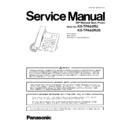Panasonic KX-TPA65RU / KX-TPA65RUB Service Manual ▷ View online
5
KX-TPA65RU/KX-TPA65RUB
3 Specifications
RF Specifications
6
KX-TPA65RU/KX-TPA65RUB
4 Technical Descriptions
4.1.
DECT Description
The frequency range of 1.88 GHz-1.90 GHz is used. Transmitting and receiving carrier between base unit and handset is same fre-
quency. Refer to.
quency. Refer to.
4.1.1.
TDD Frame Format (Full Slot)
4.1.2.
TDD Frame Format (Long Slot) for G.722 CODEC
4.1.3.
TDMA system
This system is the cycles of 1oms and has 12 physical duplex paths.
Maxmum duplex communication path is 8 in Full slot and 4 in Long slot because of securement of free slots for Hand over.
Maxmum duplex communication path is 8 in Full slot and 4 in Long slot because of securement of free slots for Hand over.
• 2-Handset Link
Traffic Bearer
A link is established between base unit and handset.
The state where duplex communication is performed.
Handset doesn't make up duplex in no free RF channels because of interference. (*1)
The state where duplex communication is performed.
Handset doesn't make up duplex in no free RF channels because of interference. (*1)
Dummy Bearer
Base unit sends Dummy-data to the all stand-by state handsets.
Handsets receive that data for synchronization and monitoring request from the base unit.
Base unit doesn't send Dummy bearer in no free RF channels because of interference. (*1)
Handsets receive that data for synchronization and monitoring request from the base unit.
Base unit doesn't send Dummy bearer in no free RF channels because of interference. (*1)
Note:
(*1) It is a feature under FCC 15 regulation and for interference avoidance.
In the case of checking RF parts, it is better in least interference condition.
A model in an FCC-unapplied area adopts too it and calls on best channel in air.
In the case of checking RF parts, it is better in least interference condition.
A model in an FCC-unapplied area adopts too it and calls on best channel in air.
7
KX-TPA65RU/KX-TPA65RUB
4.2.
Block Diagram
DCX81
DCX81
Q
SPI
Fl
ash
(64Mbit)
JT
A
G
TD
M
(PCM)
(MSG)
ANT
1
ANT
2
Q
SPI
Fl
ash
(64Mbit)
JT
A
G
UART
UART
Xt
a
l
13.824M
XI
N
SPMIC
HS
M
IP
HS
M
IN
SPEAKER
Hands
et
MIC
Hands
et
Rec
eiv
e
r
Heads
et
Mic
/Rec
eive
r
H
SSPO
U
T
P
MI
P
MI
N
SPOU
T
P
SPOU
T
N
LI
N0 or
1
LOUT
Key
(32)
Triangle
Ma
tr
ix
1.8” LCD
128*160
Truly
D
rIC
:H
X
8
3
5
3
QSPI
JTAG
I/F
UART I/F
KBIO 1-9
SPI2
3.
2V
BE
LL (B
LUE)
4.
5V
LCD_BL1
LCD_BL2
TX
R
E
Q
2
READY1
QSPI
JTAG
I/F
UART I/F
XI
N
RSTN
XOU
T
+
-
108pin
B
OOT
Res
et
88pin
SPIM<-
->SPI2
SPIM
Mas
ter
SPI2
Slave
TD
M
TD
M
SPI
Hands
hak
e
SPI
Hands
hak
e
RF Circuit
RF
I/F
HOOK_DE
T
HEAD
SET_D
ET
DCI
N0
DCI
N2
GP
IO
9
LE
DS
IN
K
1
LE
DS
IN
K
2
DC
jack
3.2v
DC
/DC
4.5V
Reg
ulator
Reset
4.5V
3.2V
IC7
IC3
Q1
1.8V
IC1
IC2
VDD_APU
1.2V
COREOUT
RSTN
IC6
1.8V
1.8V
1.8V
IC4
IC5
Master
Slave
VDD_APU
1.2V
COREOUT
8
KX-TPA65RU/KX-TPA65RUB
4.3.
Circuit Operations
4.3.1.
Outline
Handset consists of the following ICs as shown in Block Diagram
• IC1 is main MPU which controls this system and handles LED,LCD,Key scan ,detecter and RF process.
• IC2 is sub MPU which handles acoustic processing and have audio interface.
• IC3 is DC/DC Convertor.
• IC4 is Flash ROM which connected to IC1.
• IC5 is Flash ROM which connected to IC2.
• IC6 is buffer amprifier for base clock.
• IC7 is detector of power supply voltage.
• IC2 is sub MPU which handles acoustic processing and have audio interface.
• IC3 is DC/DC Convertor.
• IC4 is Flash ROM which connected to IC1.
• IC5 is Flash ROM which connected to IC2.
• IC6 is buffer amprifier for base clock.
• IC7 is detector of power supply voltage.
4.3.2.
Power Supply Circuit / Reset Circuit
The power supply of each IC is as follows.
4.3.3.
Reset Circuit and Start up of IC1 and IC2
IC7 detect divided voltage of VIN.
When VIN is over 5.6V, IC7 outputs Hi-level to IC1 with more than 20 ms of delay.
After IC1 starts, IC1 resets IC2 and outputs BOOT signal to IC2.
When VIN is over 5.6V, IC7 outputs Hi-level to IC1 with more than 20 ms of delay.
After IC1 starts, IC1 resets IC2 and outputs BOOT signal to IC2.
Reset signal for IC1 and IC2
DC
Jack
IC3
DC/DC
DC/DC
IC
䠍
Main MPU
IC2
Sub MPU
Sub MPU
Q1
TR Regurator
TR Regurator
IC4
QSPI
FLASH
QSPI
FLASH
IC5
QSPI
FLASH
QSPI
FLASH
LCD Back light
/Ringer LED
/Ringer LED
1.2V
1.8V
1.8V
3.2V
4.5V
IC6
CLK Buffer
CLK Buffer
1.2V
IC7
RESET
RESET
R8,R9
voltage-
dividing
voltage-
dividing
RESET of IC2
L108
L101
L201
BOOT
F1
䠚20ms
0.6ms
1s
VIN
IC1 RSTN
IC2 RSTN
Click on the first or last page to see other KX-TPA65RU / KX-TPA65RUB service manuals if exist.

